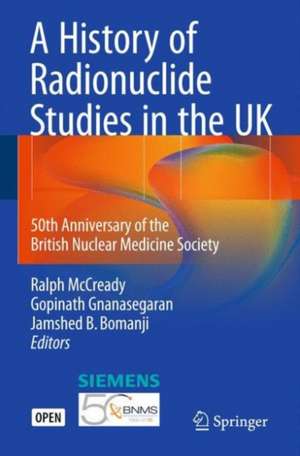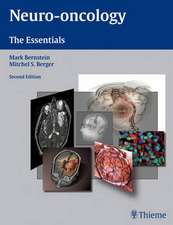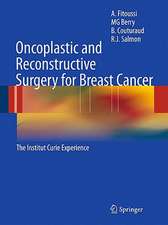A History of Radionuclide Studies in the UK: 50th Anniversary of the British Nuclear Medicine Society
Editat de Ralph McCready, Gopinath Gnanasegaran, Jamshed B. Bomanjien Limba Engleză Hardback – 21 mar 2016
| Toate formatele și edițiile | Preț | Express |
|---|---|---|
| Paperback (1) | 328.40 lei 38-45 zile | |
| Springer International Publishing – 25 apr 2018 | 328.40 lei 38-45 zile | |
| Hardback (1) | 337.46 lei 38-45 zile | |
| Springer International Publishing – 21 mar 2016 | 337.46 lei 38-45 zile |
Preț: 337.46 lei
Preț vechi: 355.22 lei
-5% Nou
Puncte Express: 506
Preț estimativ în valută:
64.57€ • 67.42$ • 53.44£
64.57€ • 67.42$ • 53.44£
Carte tipărită la comandă
Livrare economică 31 martie-07 aprilie
Preluare comenzi: 021 569.72.76
Specificații
ISBN-13: 9783319286235
ISBN-10: 3319286234
Pagini: 172
Ilustrații: XVIII, 152 p. 74 illus., 57 illus. in color.
Dimensiuni: 155 x 235 x 9 mm
Greutate: 0.35 kg
Ediția:1st ed. 2016
Editura: Springer International Publishing
Colecția Springer
Locul publicării:Cham, Switzerland
ISBN-10: 3319286234
Pagini: 172
Ilustrații: XVIII, 152 p. 74 illus., 57 illus. in color.
Dimensiuni: 155 x 235 x 9 mm
Greutate: 0.35 kg
Ediția:1st ed. 2016
Editura: Springer International Publishing
Colecția Springer
Locul publicării:Cham, Switzerland
Public țintă
Professional/practitionerCuprins
Introduction: The history of Nuclear Medicine in the UK.- The evolution from Radioisotope departments administered by Physicists with an emphasis on in vitro and vivo investigations to Nuclear Medicine Departments encompassing Imaging and therapy.- The history of the British Nuclear Medicine Society.- The development of the society from primarily a medical group to a scientific society which includes all disciplines.- From Houseman to Consultant in Nuclear Medicine.- The evolution of training in Nuclear Medicine, to include the MSc and RCR training.- Technician and Radiographer to Clinical Practitioner.- The Institute of Nuclear Medicine.- Radionuclide studies of the pathology of the brain.- Nuclear Cardiology + The Royal Brompton Department.- Paediatric radioisotope studies + Great Ormond Street Dept.- Renal studies + St Barts Department.- Radiotracer studies of human physiology.- Nuclear Medicine at the Hammersmith Including Malcolm Merrick’s work.- Monoclonal Antibody studies plus Nuclear Medicine in Nottingham.- Development of medical cyclotrons and PET in the UK.- Bone radionuclide imaging and quantitation and bone densitometry.- Radionuclide Therapy.- Hospital Radiopharmacy.- Evolution of nuclear medicine physics in the UK.- Development of computers in Nuclear Medicine.- The history of the protection of the patient in human radionuclide studies in the clinic and research.- The future direction of radiopharmaceutical development.
Notă biografică
Ralph McCready
I graduated from Queens University Belfast with a BSc in Physiology and my medical degree. As a houseman I worked in the Royal Victoria Hospital for Dr Frank Pantridge who invented the defibrillator. I was fascinated by his catheter laboratory and decided to study physiology in radiology. I moved to Guys Hospital London to study for an MSc in Radiation Physics and Biology together with a Diploma in Medical Radiological Diagnosis (DMRD). My next position was an S.H.O in the Radiology Department of the Hammersmith Hospital. During a locum in the newly opened Royal Marsden Hospital in Sutton I was offered a research position in the Institute of Cancer Research in the Isotope Unit. Eventually I became a Consultant in Nuclear Medicine in charge of the Nuclear Medicine and Ultrasound Department for over 40 years. With Nuclear Medicine and the Medical Physics departments at each end of the same corridor I was fortunate to be able to cooperate in many projects involving innovations in nuclear medicine and ultrasound equipment and radiopharmacy. Now retired I still enjoy publishing and presenting at National and International meetings. I am a Professor Emeritus at the Institute of Cancer Research and an Honorary Consultant at the Royal Sussex County Hospital in Brighton, U.K.
I graduated from Queens University Belfast with a BSc in Physiology and my medical degree. As a houseman I worked in the Royal Victoria Hospital for Dr Frank Pantridge who invented the defibrillator. I was fascinated by his catheter laboratory and decided to study physiology in radiology. I moved to Guys Hospital London to study for an MSc in Radiation Physics and Biology together with a Diploma in Medical Radiological Diagnosis (DMRD). My next position was an S.H.O in the Radiology Department of the Hammersmith Hospital. During a locum in the newly opened Royal Marsden Hospital in Sutton I was offered a research position in the Institute of Cancer Research in the Isotope Unit. Eventually I became a Consultant in Nuclear Medicine in charge of the Nuclear Medicine and Ultrasound Department for over 40 years. With Nuclear Medicine and the Medical Physics departments at each end of the same corridor I was fortunate to be able to cooperate in many projects involving innovations in nuclear medicine and ultrasound equipment and radiopharmacy. Now retired I still enjoy publishing and presenting at National and International meetings. I am a Professor Emeritus at the Institute of Cancer Research and an Honorary Consultant at the Royal Sussex County Hospital in Brighton, U.K.
Textul de pe ultima copertă
The British Nuclear Medicine Society celebrates its 50th Anniversary with this booklet, which reflects the research of many of the pioneers in the use of radionuclides for the diagnosis and therapy of human disease. Since 1949 there have been remarkable advances in radionuclide techniques and imaging equipment: from the first devices “home-made” in the many physics departments throughout the UK, to the sophisticated multimodality imagers now in everyday use in Nuclear Medicine. The BNMS has been instrumental in promoting the use of radionuclide techniques in the investigation of pathology by supporting and providing education, research and guidelines on the optimum use of radiation to help patients. The future of Nuclear Medicine is bright, thanks to improved imaging resolution, new radiopharmaceuticals, and new diagnostic and therapeutic techniques and procedures.
Caracteristici
Reflects the research of many of the pioneers in the use of radionuclides for the diagnosis and therapy of human disease Explains in detail the evolution of training in Nuclear Medicine in the UK Highlights remarkable advances in radionuclide techniques and imaging equipment







